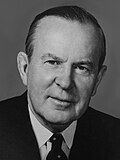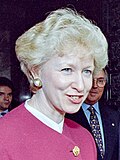
The prime minister of Canada is the official who serves as the primary minister of the Crown, chair of the Cabinet, and thus head of government of Canada. Twenty-four people (twenty-three men and one woman) have served as prime minister. Officially, the prime minister is appointed by the governor general of Canada, but by constitutional convention, the prime minister must have the confidence of the elected House of Commons. Normally, this is the leader of the party caucus with the greatest number of seats in the house. However, in a minority parliament the leader of an opposition party may be asked to form a government if the incumbent government resigns and the governor general is persuaded that they have the confidence of the House.
Contents
- Model
- Term
- Prime ministers
- Timeline
- Lifespan timeline
- See also
- References
- Further reading
- External links
By constitutional convention, a prime minister holds a seat in parliament and, since the early 20th century, this has more specifically meant the House of Commons. [1]
The 24th and current prime minister is Mark Carney, who assumed office on 14 March 2025. There are currently six living former prime ministers. The most recent former prime minister to die was Brian Mulroney, on 29 February 2024.






























